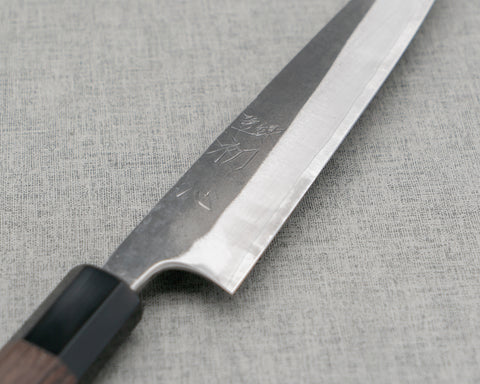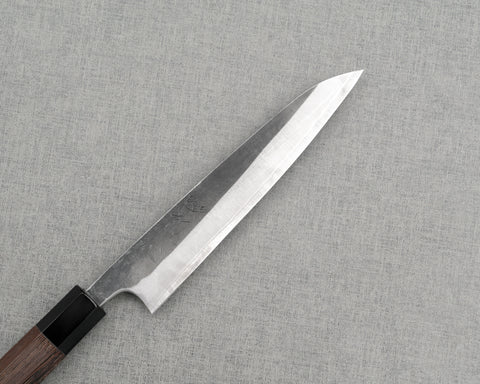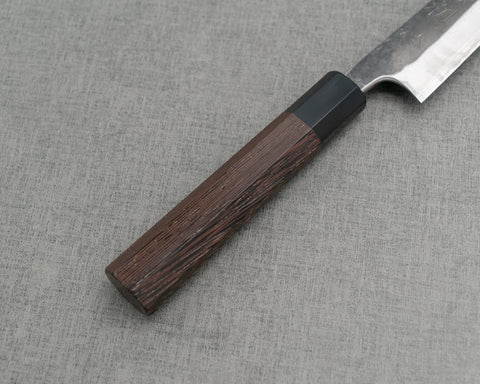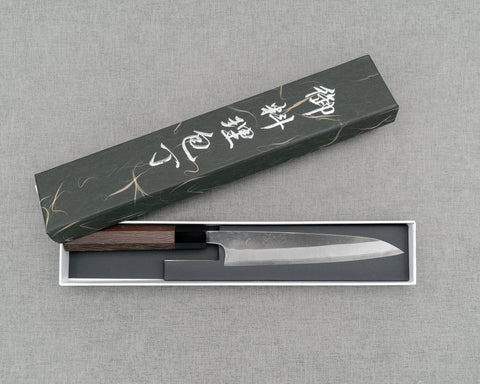Hatsukokoro






Hatsukokoro "Kurokaze" Shirogami #2 Kurouchi 150mm Petty
目前沒有提供取貨服務
Hatsukokoro 'Kurokaze (Black Wind)' Petty is a blend of traditional craftsmanship and modern practicality. This 150mm petty knife uses the exceptionally pure Shirogami #2 (White Steel #2) core, celebrated for its capacity to take a surgically sharp edge and maintain it with incredible tenacity. This high-carbon steel ensures your cuts are effortlessly precise and makes re-sharpening a breeze. The blade's rustic 'Kurouchi' finish not only provides a raw handcrafted aesthetic. With Hatsukokoro's competitive value for money, the 'Kurokaze' offers a direct path to the world of high-performance Japanese knife, combining an outstanding cutting feel with authentic finish.
Spec:
- Origin (Made in): Tosa, Kōchi Prefecture, Japan
- Brand: Hatsukokoro
- Knife Type: Petty
- Blade
- Construction: San Mai
- Grind: Symmetrical Double-Bevel
- Hagane (Core Steel): Shirogami #2 (White #2)
- Jigane (Cladding): Stainless Steel
- Hardness: 62 HRC
- Hand-forged, hand-ground, hand-sharpened
- Blade Finishes:
- Kurouchi
Kasumi - Blade Length: 150mm (5.9")
- Blade Height (at heel): 29mm
- Spine Thickness
- Above heel: 3.9mm
- Middle: 2.1mm
- Handle
- Shape: Hachikaku (Octagonal)
- Material: Wenge
- Kuchiwa: Black Buffalo Horn
- Length: 115mm
- Overall Length: 280mm
- Weight: 90g (3.17oz)
- Hand Chiseled Mark: In Japanese Kanji "Trademark Hatsukokoro" (登録 初心)
Care:
Shirogami #2 (white #2) steel is one of the most popular types of high carbon steel found in Japanese kitchen knives (Wa Knives). It is not stainless, therefore you must wipe your knife dry after each use, in particular the core steel not covered by the stainless cladding. Patina will develop over time, which will appear as “discoloration” on the cutting edge, but that is the nature of carbon steel - not a defect. The stainless cladding covers a large part of the blade, making maintenance easier but still preserving the cutting and sharpening pleasure of the Shirogami core. Avoid cutting into bones, frozen foods, hard fruit pits.
Cutting Surface:
Recommended cutting surface: wood, rubberized boards and high-end composites, and quality plastics such as polyethene make acceptable cutting surfaces, and will help protect and prolong knife’s edge. AVOID glass, metal, countertops, and other rigid, non-forgiving surfaces.
Sharpening:
We recommend sharpening all quality Japanese knives on whetstones, as we believe they yield the best results for your knives.
